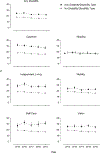Trends in cigarette smoking prevalence and status among U.S. adults with disabilities, 2015-2019
- PMID: 36535098
- PMCID: PMC9930180
- DOI: 10.1016/j.drugalcdep.2022.109738
Trends in cigarette smoking prevalence and status among U.S. adults with disabilities, 2015-2019
Abstract
Introduction: The prevalence of current cigarette smoking is higher in people with disabilities compared to those without. However, little is known about smoking status and trends in smoking by disability functioning domain.
Methods: Data from the 2015-2019 National Surveys on Drug Use and Health were used to estimate the prevalence of past-month and daily cigarette smoking, former smoking, and nicotine dependence for people with any disability and six disability functioning domains. Logistic regression models estimated the odds of each outcome by disability domain compared to no disability, adjusting for sociodemographic factors.
Results: From 2015-2019, the overall prevalence of current cigarette smoking (23.3% vs. 16.7%) and the proportion of those with nicotine dependence (14.6% vs 8.0%) was higher in people with any disability compared to those without (ps < 0.001). The prevalence of current cigarette smoking decreased while the prevalence of former cigarette smoking increased from 2015 to 2019 (ps < 0.05). People with any disability had higher odds of current smoking (AOR=1.20; 95% CI 1.16, 1.25) and similar odds of former smoking (AOR=1.00; 95% CI 0.95, 1.06) compared to people without disabilities. Odds of current and former smoking varied by domain.
Conclusion: The prevalence of cigarette smoking among people with any disability decreased over time but remained higher than those without. People with any disability had similar odds of former smoking, though differences existed by disability domain. Future research should explore additional smoking and quit behaviors by disability functioning domain.
Keywords: Inequities, tobacco use; Persons with disabilities.
Copyright © 2022 Elsevier B.V. All rights reserved.
Conflict of interest statement
Conflict of Interest No conflict declared.
Figures


References
-
- Leventhal AM, Bello MS, Galstyan E, Higgins ST, Barrington-Trimis JL. Association of cumulative socioeconomic and health-related disadvantage with disparities in smoking prevalence in the United States, 2008 to 2017. JAMA Intern Med. 2019;179(6):777. doi:10.1001/jamainternmed.2019.0192 - DOI - PMC - PubMed
Publication types
MeSH terms
Grants and funding
LinkOut - more resources
Full Text Sources
Medical
Miscellaneous

